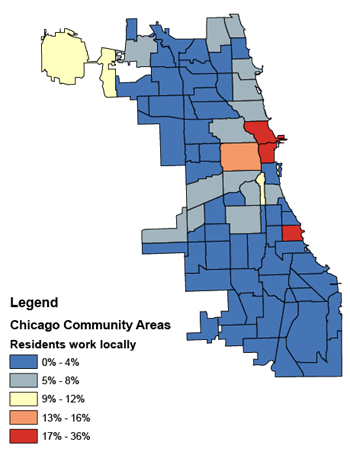
Interfaith Housing Development Corporation
In many cases, the people who work in a community are a different group from the people who live there.
This is the fourth of five posts in our "jobs-housing puzzle" series. Every day thousands of people commute to and from each of Chicago’s neighborhoods and suburbs, but only a small minority spends the work day in the same community that it wakes up in. Overwhelmingly people do not live and work in the same place. In this blog series, we’ll cover current statistics on where people are and where they’re going, and what that means for the communities in which they live and work. You can find all the posts in the series here.
The people who work in any individual community and the people who live there overlap much less than we might expect. When we think of an area we tend to think of the community as the people who live there. But people who work in that area also make use of that place and have a stake in it. And those two populations may be very different.

The majority of community areas have between 0 and 8 percent of their population working and living in the same area.
For example, the Lower West Side community area (Pilsen) is known as a Mexican neighborhood. This is reflected in the demographics of workers who live there, 60.7 percent of whom are Latino (non-Latinos are overrepresented in the worker demographics because they are more likely to be of working age). But of the people who work in the community area, only 33.7 percent are Latino (and most of them live in a different neighborhood). There is a significant inflow of non-Latino White, African-American and Asian workers.
Generally speaking, the work population of communities tends to be more racially and ethnically diverse than the populations that live there. The two populations can also be quite different in terms of gender, age and income.
This is an important fact to consider for those who are active in community organizing and development, especially when considering how the two communities can work together to achieve mutually beneficial goals and resolve conflicts between the interests of those who use the place as a work space and those who live there.
A series of community development workshops in Uptown on the north side, organized by the Metropolitan Planning Council (MPC), had significant attendance from people who work in the community as well as residents. At the first meeting 14 percent of attendees said they work in the community but do not live there, and this increased to 19 percent at the second meeting. There were also a sizeable number of attendees who have some other interest in the community and neither live nor work there (23 percent at the first meeting, 17 percent at the second).
It is also interesting to note that despite our findings that relatively few people live and work in the same community, this group made up around a quarter of the attendees at this meeting—suggesting that they are more active in community affairs.
Workers are an integral part of any community, supporting local business and contributing to a lively atmosphere. Anyone speaking to a community needs to realize they are really speaking to two: the residents and the workers.